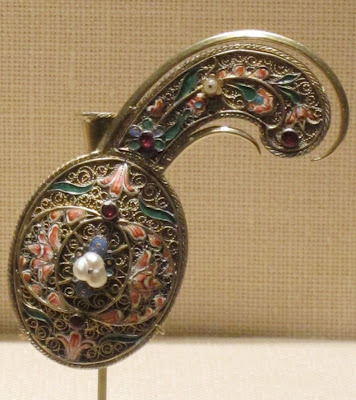 | |||||
| QAJAR PERIOD (1779-1925) 19TH CENTURY SILVER ORNAMENT |
The New Galleries for the Art of the Arab Lands at The Metropolitan Museum of Art are not overrun with examples of the boteh or paisley motif, but what is found is outstanding. As with the Mughal flask of last post, I was onto a needle-in-a-palace search, this time for an 19th-century silver turban ornament from Iran's Qajar period, a richly gilded and wire-filigree patterned oval with applied enamels, a pearl center and a boteh on top.
The area's small Edward C. Moore Collection room had been first overlooked in the walk round and round. There are several rooms for private collections, each with its own door. And the Moore Collection houses one of them. Mr. Moore, a 19th-century New Yorker, had been the owner of the ornament.
It seems that all kinds of important men have worn some style of head wrap over the ages to set themselves apart from commoners. A power look in Renaissance Florence appears to have included the loosely-tied head coverings certain well-connected men threw on for profile portraits that are now on display in another of the Met's second-floor exhibits. The princes of the church had their full vocabulary of miters with trailing streamers and beanies. And the Arab royals had their perfect turbans, many times with head ornaments that held big, fluffy feathers that tended to curl into the boteh shape at the top of royal heads.
It could be conjectured that because of 15th-century Florence's interest in eastern textiles, scholarship and culture, the Renaissance capital had been loving the head-wrap look. But it was the Arab regal who would have won the Global Style Award for his perfectly wrapped turban topped with a beautiful ornament and maybe an attention-getting feather bobbing ever so slightly as he spoke. JP
